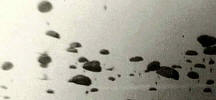 Look
Who's Coming To Dinner Look
Who's Coming To Dinner
Taken by a Dutch citizen on the afternoon of September
17, 1944 as the 508th PIR floated down in Drop Zone 'T' in the
fields of Groesbeek, a suburb of Nijmegen, Holland.
Although resistance was light during the para-drop, there were many
casualties in the days that followed. |
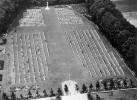 Mook
Cemetery, 1947 Mook
Cemetery, 1947
Seen from the air approximately two years
after the end of hostilities, this cemetery, even though temporary,
has all of the sense of symmetry that is found in a military
cemetery.
The Mook cemetery was, and remains, a British Commonwealth War
Graves Commission cemetery.
|
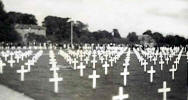
Molenhoek Cemetery, September 17, 1945
Molenhoek was designated as
the American temporary cemetery and all American war dead were either re-interred at Margraten
when that formal cemetery was completed or sent home at the request
of family. Although considered to be temporary, the grounds and
neatly aligned wooden crosses still evoke a sense of peace and dignity. Roger Kitchen took this shot of
Molenhoek
Cemetery when he visited the graves of fallen friends (see also
Purdue Grave Marker)
on the first anniversary of Operation Market Garden.
|
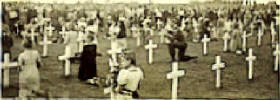
Dutch citizens at the 82nd Airborne Division cemetery
at Molenhoek Holland September 17, 1945
The sacrifices made by American paratroopers were not
lost on the Dutch citizenry. Many of them adopted a grave that
commemorative day to honor the men that had given their lives in freeing
Holland from tyranny. That rite of adoptive caring continues to this
day, more than 60 years after Operation Market Garden was launched. |
|
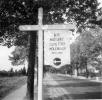 Molenhoek
Entrance (ca. 1945) Molenhoek
Entrance (ca. 1945)
was marked by a simple roadside sign
(courtesy of Francis Mahan collection) |
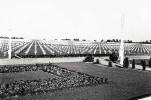
Margraten Cemetery (ca. 1946)
became the final resting place of all those whose family decided
to let them rest with their comrades. This photo was taken while the
temporary crosses were still in place.
(courtesy of Francis Mahan collection) |


